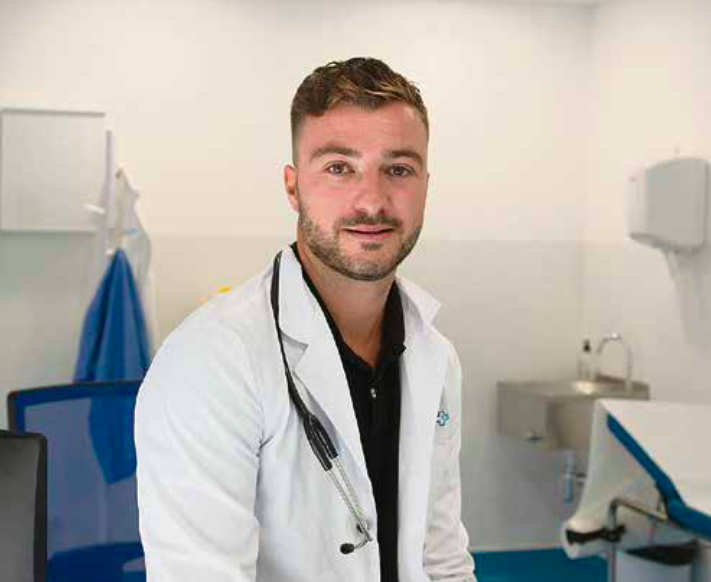

AZITROMICIN-ZDOROV'A

Ask a doctor about a prescription for AZITROMICIN-ZDOROV'A

How to use AZITROMICIN-ZDOROV'A
INSTRUCTIONS FOR MEDICAL USE OF VANCOMYCIN (VANCOMYCIN)
VANCOMYCIN (VANCOMYCIN)
COMPOSITION
Active substance: vancomycin; 1 vial contains vancomycin hydrochloride equivalent to 500 mg or 1000 mg of vancomycin; excipients: sodium hydroxide, hydrochloric acid, water for injections.
PHARMACEUTICAL FORM
Lyophilisate for solution for infusions.
MAIN PHYSICOCHEMICAL PROPERTIES
Lyophilized powder or mass from white to yellow-brown in color.
PHARMACOTHERAPEUTIC GROUP
Antimicrobial agents for systemic use. Glycopeptide antibiotics. ATC code J01X A01.
PHARMACOLOGICAL PROPERTIES
PHARMACODYNAMICS
Vancomycin is a tricyclic glycopeptide antibiotic obtained from Amycolatopsis orientalis, effective against many Gram-positive microorganisms. The bactericidal action of vancomycin is due to the suppression of bacterial cell wall synthesis by inhibiting the polymerization of glycopeptides and the selective inhibition of bacterial RNA synthesis. There is no cross-resistance between vancomycin and other antibiotics. Vancomycin is not active in vitro against Gram-negative bacilli, mycobacteria, or fungi.
The combination of vancomycin and an aminoglycoside acts synergistically in vitro against many strains of Staphylococcus aureus, Streptococcus bovis, enterococci, and Streptococcus viridans group.
It has been proven that vancomycin is effective against most strains of the following microorganisms, both in vitro and in clinical infections, as described in the "Method of application and dosage" section.
Aerobic Gram-positive microorganisms
Diphtheroids
Enterococci (e.g., Enterococcus faecalis)
Staphylococci, including Staphylococcus aureus and Staphylococcus epidermidis (including heterogeneous methicillin-resistant strains)
Streptococcus bovis
Streptococcus viridans group
The following in vitro data are available, but their clinical significance is unknown.
Vancomycin demonstrated in vitro MIC (minimum inhibitory concentration) of 1 μg/mL or less against most (≥ 90%) of the following strains of streptococci and MIC of 4 μg/mL or less against most (≥ 90%) of the strains of other listed microorganisms; however, the safety and efficacy of vancomycin in treating clinical infections caused by these microorganisms have not been established in adequate and well-controlled clinical trials.
Aerobic Gram-positive microorganisms
Listeria monocytogenes
Streptococcus pyogenes
Streptococcus pneumoniae (including penicillin-resistant strains)
Streptococcus agalactiae
Anaerobic Gram-positive microorganisms
Actinomyces species
Lactobacillus species
PHARMACOKINETICS
Vancomycin is poorly absorbed after oral administration.
In patients with normal renal function, multiple intravenous administration of 1 g of vancomycin (15 mg/kg), administered over 60 minutes, results in mean plasma concentrations of approximately 63 μg/mL immediately after completion of the infusion, 23 μg/mL 2 hours after the infusion, and 8 μg/mL 11 hours after the end of the infusion. Multiple doses of 500 mg, administered over 30 minutes, result in mean plasma concentrations of approximately 49 μg/mL after completion of the infusion, 19 μg/mL 2 hours after the infusion, and 10 μg/mL 6 hours after the infusion. Plasma concentrations during multiple dosing are similar to those after a single dose.
The mean half-life of vancomycin in plasma is from 4 to 6 hours in patients with normal renal function. Within the first 24 hours, about 75% of the administered dose of vancomycin is excreted in the urine by glomerular filtration. The mean plasma clearance is about 0.058 L/kg/h, and the mean renal clearance is about 0.048 L/kg/h. Renal dysfunction slows down the elimination of vancomycin. In patients with a removed kidney, the mean half-life is 7.5 days. The distribution coefficient is from 0.3 to 0.43 L/kg. There is no apparent metabolism of the drug. About 60% of the intraperitoneal dose of vancomycin administered during peritoneal dialysis is absorbed systemically within 6 hours. Serum concentrations of about 10 μg/mL are achieved after intraperitoneal injection of 30 mg/kg of vancomycin.
However, the safety and efficacy of intraperitoneal administration of vancomycin have not been established in adequate and well-controlled studies (see "Special Instructions" section).
The overall systemic and renal clearance of vancomycin may be reduced in the elderly.
Almost 55% of the administered vancomycin is bound to plasma proteins at vancomycin serum concentrations from 10 to 100 μg/mL. After intravenous administration of vancomycin, inhibitory concentrations are present in pleural, pericardial, ascitic, and synovial fluids; in urine; in peritoneal dialysis fluid; and in atrial appendage tissue. Vancomycin does not easily diffuse through normal meninges into cerebrospinal fluid; but when meninges are inflamed, penetration into cerebrospinal fluid occurs.
CLINICAL CHARACTERISTICS
INDICATIONS
- For the treatment of serious or severe infections caused by susceptible strains of methicillin-resistant (β-lactam-resistant) staphylococci.
- For the treatment of patients with allergies to penicillins and cephalosporins, including when the use of other agents, including penicillins or cephalosporins, has not been successful.
- For the treatment of infections caused by vancomycin-susceptible microorganisms resistant to other antimicrobial agents.
- For the treatment of staphylococcal endocarditis caused by S. viridans or S. bovis. In endocarditis caused by enterococci (e.g., E. faecalis), vancomycin is effective only in combination with aminoglycosides.
- For the treatment of diphtheroid endocarditis.
- For the treatment of early prosthetic valve endocarditis caused by S. epidermidis or diphtheroids, in combination with rifampicin, an aminoglycoside, or both.
- For the treatment of other infections caused by staphylococci, including septicemia, bone infections, lower respiratory tract infections, skin and skin structure infections.
- For the treatment of localized purulent staphylococcal infections as an adjunct to appropriate surgical measures.
- For the treatment of antibiotic-associated pseudomembranous colitis caused by Clostridium difficile (oral administration).
CONTRAINDICATIONS
Increased sensitivity to vancomycin or to any other component of the medicinal product.
INTERACTION WITH OTHER MEDICINAL PRODUCTS AND OTHER TYPES OF INTERACTIONS
Concomitant administration of vancomycin and anesthetics has been associated with erythema, histamine-like hyperemia (see "Special Instructions" section), and anaphylactoid reactions (see "Adverse Reactions" section).
Monitoring of renal function is recommended in patients who are concomitantly or sequentially receiving vancomycin and other potentially nephrotoxic and/or ototoxic medicinal products, such as amphotericin B, aminoglycosides, bacitracin, polymyxin B, colistin, viomycin, or cisplatin (see "Special Instructions" section). Due to the synergistic effect with gentamicin, the maximum dose of vancomycin should be limited to 500 mg every 8 hours.
When administering vancomycin during or immediately after surgery, the action of muscle relaxants, such as succinylcholine, may increase or prolong. Vancomycin should not be mixed with aminophylline or fluorouracil, as the properties of vancomycin may be significantly weakened over time. The combination of vancomycin and aminoglycosides acts synergistically in vitro against Staphylococcus aureus, non-enterococcal group D streptococci, enterococci, and Streptococcus species (various species). Medicinal products that reduce intestinal peristalsis are contraindicated in pseudomembranous colitis. Cholestyramine reduces the effectiveness of vancomycin.
Concomitant administration of vancomycin and piperacillin/tazobactam may lead to the development of acute renal failure.
SPECIAL INSTRUCTIONS
REACTIONS AT THE INFUSION SITE
Rapid bolus administration (e.g., over several minutes) may be accompanied by excessive arterial hypotension, including shock and, rarely, cardiac arrest. Therefore, to reduce the risk of hypotensive reactions, the patient's arterial blood pressure should be monitored during administration of the medicinal product.
Vancomycin should be administered only intravenously due to the risk of developing necrosis of soft tissues.
Vancomycin hydrochloride for injection should be administered as a diluted solution over a period of not less than 60 minutes to prevent the development of infusion reactions. Discontinuation of the infusion usually leads to rapid resolution of these reactions. Reactions related to the rate of administration of the medicinal product may occur at any concentration and rate of administration and may disappear after completion of administration of the medicinal product.
NEPHROTOXICITY
Patients with renal insufficiency, including anuria, should be treated with vancomycin with caution, as the possibility of developing toxic effects is much higher in conditions of prolonged maintenance of high concentrations of the drug in the blood. The risk of toxicity increases with high concentrations of the drug in the blood or with prolonged therapy.
Regular monitoring of vancomycin concentrations in the blood is indicated when using high doses of the drug and with prolonged use, particularly in patients with impaired renal function or worsening hearing, as well as when concomitantly using nephrotoxic substances (in particular, piperacillin/tazobactam) (see "Method of application and dosage" and "Interaction with other medicinal products" sections).
The systemic effect of vancomycin may lead to the development of acute kidney injury (AKI). The risk of AKI increases with increasing systemic exposure/serum concentration of the drug. It is necessary to monitor renal function in all patients, especially in patients with existing renal dysfunction, patients with comorbidities that predispose to the development of renal insufficiency, and in patients who are concomitantly taking nephrotoxic drugs.
OTOXICITY
During treatment with vancomycin, there is a risk of developing an ototoxic effect. Ototoxicity can be transient or persistent. Ototoxicity has been observed in most patients who received excessive doses, already had decreased hearing, or were concomitantly receiving other ototoxic medicinal products (e.g., aminoglycosides). Vancomycin should be administered with caution to patients with renal insufficiency, given the significantly increased risk of toxicity with high concentrations in the blood over a prolonged period.
Dosing of vancomycin should be adjusted for patients with renal dysfunction (see "Method of application and dosage" section).
SEVERE CUTANEOUS ADVERSE REACTIONS
During treatment with vancomycin, severe cutaneous adverse reactions have been observed in patients, including Stevens-Johnson syndrome, toxic epidermal necrolysis, drug reaction with eosinophilia and systemic symptoms (DRESS syndrome), which can lead to a fatal outcome (see "Adverse Reactions" section). Cutaneous symptoms reported include skin rash, mucosal involvement, and blisters. Most such reactions occurred within a few days to 8 weeks after the start of treatment with vancomycin.
Patients should be informed about the symptoms of severe skin reactions when prescribing vancomycin. If suspected or symptoms of such reactions occur, vancomycin should be discontinued immediately, and alternative treatment should be considered. If a patient has a history of severe cutaneous adverse reactions to vancomycin, treatment with vancomycin should not be prescribed again.
CLOSTRIDIUM DIFFICILE-ASSOCIATED DIARRHEA (CDAD)
With the use of almost all antibacterial agents, including vancomycin, cases of diarrhea associated with Clostridioides difficile have been reported. This diarrhea can range in severity from mild diarrhea to life-threatening colitis. Treatment with antibacterial agents alters the normal flora of the colon, leading to the overgrowth of C. difficile.
C. difficile produces toxins A and B, which contribute to the development of CDAD. Hyper-toxigenic strains of C. difficile cause increased morbidity and mortality, as these infections can be refractory to antimicrobial therapy and may require colectomy. The possibility of CDAD should be considered in all patients who develop diarrhea after antibiotic use. Since CDAD has been reported to occur over two months after the administration of antibacterial agents, a careful medical history should be taken.
If CDAD is suspected or confirmed, the ongoing use of antibacterial agents not directed against C. difficile may need to be discontinued. Appropriate fluid and electrolyte management, protein supplementation, treatment of C. difficile with antibacterial agents, and surgical evaluation should be performed as clinically indicated.
EYE DISORDERS
Vancomycin is not intended for intracameral or intravitreal use.
HEMORRHAGIC OCCLUSIVE RETINAL VASCULITIS
Hemorrhagic occlusive retinal vasculitis, including irreversible vision loss, has occurred in patients who received vancomycin during or after cataract surgery with intraocular use. The safety and efficacy of vancomycin for intraocular or intravitreal use have not been established. Vancomycin is not indicated for the prevention of endophthalmitis.
There have been reports of clinically significant serum concentrations in some patients who received treatment for active pseudomembranous colitis caused by C. difficile after multiple oral administrations of vancomycin.
LONG-TERM USE OF VANCOMYCIN
Long-term use of vancomycin may lead to the growth of non-susceptible microorganisms. Close monitoring of the patient is essential. If a superinfection develops during therapy, appropriate measures should be taken.
There have been reports of pseudomembranous colitis due to the development of C. difficile in patients who received vancomycin intravenously.
SERIAL HEARING TESTS
Serial hearing tests may be useful in minimizing the risk of ototoxicity.
NEUTROPENIA
Reversible neutropenia has been reported in patients receiving vancomycin (see "Adverse Reactions" section). Periodic determination of the white blood cell count is recommended in patients receiving prolonged treatment with vancomycin, as well as in cases of concomitant use of drugs that may cause neutropenia.
INTRAVENOUS ADMINISTRATION
Vancomycin irritates tissues and should be administered only intravenously. Intramuscular administration or extravasation may cause pain, tenderness, and tissue necrosis. Thrombophlebitis may occur, the frequency and severity of which can be minimized if the diluted solution of the medicinal product (2.5-5 g/L) is administered slowly and the infusion site is changed.
FREQUENCY OF INFUSION-RELATED COMPLICATIONS
The frequency of infusion-related complications (including arterial hypotension, flushing, hyperemia, urticaria, and itching) increases with concomitant administration of anesthetics; therefore, anesthesia is recommended to be started after completion of slow (60-minute) infusion of vancomycin.
INTRATHECAL ADMINISTRATION
The safety and efficacy of vancomycin for intrathecal (intralumbar or intraventricular) administration have not been established.
THERE HAVE BEEN REPORTS OF CASES
There have been reports of cases where the administration of sterile vancomycin intraperitoneally during continuous ambulatory peritoneal dialysis (CAPD) led to the development of chemical peritonitis syndrome. The syndrome manifested as the appearance of a cloudy dialysate, which could be accompanied by abdominal pain of varying severity and fever. This syndrome is transient and disappears after discontinuation of intraperitoneal administration of vancomycin.
VANCOMYCIN ADMINISTRATION
Vancomycin should not be prescribed in the absence of a proven or suspected bacterial infection or for prophylaxis, as this may not benefit the patient and may increase the risk of developing bacteria resistant to the medicinal product.
CHILDREN
In children, it is desirable to confirm the desired concentrations of vancomycin in serum. Concomitant administration of vancomycin and anesthetic agents has been associated with erythema and histamine-like hyperemia in children.
ELDERLY PATIENTS
Natural decrease in glomerular filtration with age may be the reason for increased concentration of vancomycin in serum if the dosage is not adjusted. The dosage of vancomycin should be adjusted for elderly patients.
LIVER FUNCTION MONITORING IS REQUIRED
Liver function monitoring is required, as liver disease during vancomycin treatment may worsen due to increased levels of bilirubin, aspartate aminotransferase (AST), alanine aminotransferase (ALT), alkaline phosphatase, and, rarely, lactate dehydrogenase and gamma-glutamyltransferase.
VANCOMYCIN SHOULD BE USED WITH CAUTION
Vancomycin should be used with caution in patients with allergic reactions to teicoplanin, as cases of cross-allergic reactions have been described. In some patients with inflammatory diseases of the intestinal mucosa, significant systemic absorption may occur with oral administration of vancomycin. Therefore, there is a risk of developing adverse reactions associated with parenteral administration of vancomycin. Vancomycin should be used with particular caution in premature infants due to the immaturity of their renal system, which may result in increased serum concentrations of vancomycin.
MONITORING OF VANCOMYCIN CONCENTRATION IS RECOMMENDED
Monitoring of vancomycin concentration in serum is recommended in premature infants and infants.
IT HAS BEEN FOUND THAT PATIENTS WITH BURNS
It has been found that patients with burns have a higher overall clearance of vancomycin and therefore require more frequent administration of the medicinal product with an increased dose. During treatment of such patients, it is recommended to individually determine the dose of vancomycin and carefully monitor their condition.
INFORMATION FOR PATIENTS
Patients should know that antibacterial agents, including vancomycin hydrochloride for injection, should be used only to treat bacterial infections. These agents do not treat viral infections (e.g., the common cold). If the vancomycin medicinal product is prescribed for the treatment of a bacterial infection, patients should be informed that, although they usually start feeling better at the beginning of the treatment course, the medicinal product should be taken exactly as prescribed. Missing doses or not completing the full course of therapy may reduce the effectiveness of the treatment and increase the likelihood of developing resistance to vancomycin hydrochloride for injection or other antibacterial agents in the future.
Antibiotic-associated diarrhea usually resolves after discontinuation of the antibiotic. However, in some cases, watery stools with blood may occur after the start of antibiotic treatment, even two or more months after the last dose of the antibiotic. If this occurs, the patient should immediately consult their doctor.
USE DURING PREGNANCY OR BREASTFEEDING
PREGNANCY
Studies on the effect of vancomycin on reproductive ability in animals have not been conducted. It is not known whether vancomycin can affect reproductive ability.
In a controlled clinical study, the potential ototoxic and nephrotoxic effects of vancomycin on infants were evaluated when the medicinal product was administered to pregnant women for the treatment of serious staphylococcal infections, which were accompanied by intravenous drug abuse. Vancomycin was detected in umbilical cord blood. No sensorineural hearing loss or nephrotoxicity associated with vancomycin administration was observed. One child whose mother received vancomycin in the third trimester experienced conductive hearing loss, which was not attributed to the effect of vancomycin. Since the number of patients treated in this study was limited, and vancomycin was administered only in the second and third trimesters, it is not known whether vancomycin causes harm to the fetus. Vancomycin should be prescribed during pregnancy only when absolutely necessary, when the expected benefit to the mother outweighs the risk to the fetus, and with monitoring of vancomycin concentration in serum.
BREASTFEEDING
The medicinal product penetrates into breast milk. Caution should be exercised during breastfeeding. In connection with the possible occurrence of adverse reactions, a decision should be made to discontinue the use of vancomycin or to discontinue breastfeeding, depending on the need for its use in the mother.
ABILITY TO AFFECT REACTION RATE WHEN DRIVING VEHICLES OR OPERATING MACHINERY
During the use of the medicinal product, the ability to concentrate may be reduced, which should be taken into account when driving a car or performing work that requires increased attention.
METHOD OF APPLICATION AND DOSAGE
Vancomycin should be administered for intravenous use in the treatment of life-threatening infections. In no case should vancomycin be administered as a bolus injection or intramuscularly due to pain and possible necrosis at the injection site.
Reactions to the administration of the medicinal product may depend on both the concentration of the solution and the rate of its administration. For the treatment of adults, it is recommended that the concentration during administration not exceed 5 mg/mL, and the rate of administration not exceed 10 mg/min. Individual patients who need to limit the amount of fluid administered may receive the medicinal product at a concentration of up to 10 mg/mL, but the rate of administration should not exceed 10 mg/min. An infusion rate of 10 mg/min or less is associated with a lower frequency of infusion-related adverse events (see "Adverse Reactions" section). However, infusion-related adverse reactions may occur at any rate of infusion or concentration.
The duration of treatment depends on the therapeutic indications for which the medicinal product is used.
PATIENTS WITH NORMAL RENAL FUNCTION
The usual daily dose for intravenous administration is 2 g, administered as 500 mg every 6 hours or 1 g every 12 hours. Each dose should be administered at a rate of not more than 10 mg/min or over a period of not less than 60 minutes, depending on which is longer. Other patient-related factors, such as age or the presence of obesity, may require modification of the usual daily dose for intravenous administration.
CHILDREN
The usual dose of vancomycin is 10 mg/kg of body weight every 6 hours. The solution should be administered over a period of not less than 60 minutes. In these patients, careful monitoring of vancomycin concentration in serum may be justified.
NEWBORN INFANTS
The maximum daily dose may be reduced.
Newborn infants under 7 days of age: the initial dose is 15 mg/kg of body weight, followed by 10 mg/kg of body weight every 12 hours.
Newborn infants over 7 days and up to 1 month of age: the initial dose is 15 mg/kg of body weight, followed by 10 mg/kg of body weight every 8 hours. One dose should be administered over 60 minutes.
Preterm infants: in preterm infants, the clearance of vancomycin is decreased, so it may be necessary to increase the intervals between administrations of the dose. A dose reduction may be required due to decreased renal function. Careful monitoring of vancomycin concentration in serum is recommended in these patients.
PATIENTS WITH RENAL DYSFUNCTION AND ELDERLY PATIENTS
For patients with impaired renal function, dosage adjustment is necessary. A greater reduction in dose than expected may be required for preterm newborns and elderly individuals due to decreased renal function.
Measurement of vancomycin concentration in serum may be useful in optimizing therapy, especially in critically ill patients with impaired renal function. Serum concentrations of vancomycin can be determined using microbiological analysis, radioimmunoassay, fluorescence polarization immunoassay, fluorescence immunoassay, or high-performance liquid chromatography.
If creatinine clearance can be measured or accurately estimated, the dosage for most patients with renal insufficiency can be calculated using the following table. The dose of vancomycin per day in mg is approximately 15 times the glomerular filtration rate in mL/min. The dose should be adjusted according to the creatinine clearance in the table.
| Creatinine clearance (mL/min) | Vancomycin dose (mg/day) |
| 100 | 1545 |
| 90 | 1390 |
| 80 | 1235 |
| 70 | 1080 |
| 60 | 925 |
| 50 | 770 |
| 40 | 620 |
| 30 | 465 |
| 20 | 310 |
| 10 | 155 |
The initial dose of the medicinal product should be 15 mg/kg of body weight, including for patients with mild to moderate renal insufficiency.
The table does not apply to the treatment of patients with a single functioning kidney. In such cases, the initial dose of vancomycin should be 15 mg/kg of body weight before achieving a therapeutic serum concentration. The maintenance dose is 1.9 mg/kg/day. For patients with significant renal insufficiency, it is recommended to administer 250-1000 mg of the medicinal product once a day with an interval of several days. In the case of anuria, the recommended dose is 1000 mg every 7-10 days.
When the serum creatinine concentration is known, the creatinine clearance can be determined using the following formula (taking into account the patient's sex, body weight, and age). However, to obtain an accurate value, creatinine clearance should be measured.
| Men: | Body weight [kg] × (140 – age [years]) |
| 72 × serum creatinine concentration [mg/dL] |
Women: 0.85 × the value obtained using the above formula.
Serum creatinine should be determined in a stable state of renal function. Otherwise, the calculated value for creatinine clearance may be inaccurate. The calculated clearance is an overestimation of the actual clearance in patients who are in states such as (1) decreased renal function, e.g., shock, severe heart failure, or oliguria; (2) where the normal relationship between muscle mass and total body weight is absent, e.g., in patients with obesity or liver disease, edema, or ascites; (3) accompanied by dehydration, malnutrition, or immobility.
INTRAVENOUS ADMINISTRATION
During administration, the contents of the vial of vancomycin hydrochloride for injection are dissolved in sterile water for injections to a concentration of vancomycin of 50 mg/mL (see Table 2).
| Nominal vancomycin content in the vial | Volume of solvent |
| 500 mg | 10 mL |
| 1000 mg | 20 mL |
The reconstituted solution should be stored at a temperature of 2-8°C for 96 hours.
The reconstituted solution requires further dilution: to the solution containing 500 mg in 10 mL, 100 mL of one of the following infusion solutions should be added, and to the solution containing 1000 mg in 20 mL, 200 mL of one of the following infusion solutions should be added. The required dose, diluted in this way, should be administered as intermittent intravenous infusions over a period of not less than 60 minutes.
From a microbiological point of view, the solution should be administered immediately after dilution. The final concentration of the resulting solution of vancomycin should not exceed 5 mg/mL.
COMPATIBILITY WITH INFUSION FLUIDS
The reconstituted solution of vancomycin can be diluted with the following infusion solutions:
- 5% glucose solution for injections;
- 5% glucose solution for injections and 0.9% sodium chloride solution for injections;
- Ringer's lactate solution for injections;
- Ringer's lactate solution for injections and 5% glucose solution for injections;
- 0.9% sodium chloride solution for injections.
Before administration, it should be ensured that the solution is clear, colorless, and does not contain mechanical inclusions.
The medicinal product should be administered continuously intravenously over a period of 60 minutes.
The solution of vancomycin has a low pH and may cause chemical or physical instability of other compounds when mixed.
INCOMPATIBILITY
It has been shown that mixtures of vancomycin solutions and beta-lactam antibiotics are physically incompatible. The likelihood of precipitate formation increases with increasing concentration of vancomycin. It is recommended to thoroughly flush the infusion systems between the administration of these antibiotics. It is also recommended to dilute vancomycin solutions to a concentration of 5 mg/mL or less.
The diluted solution of vancomycin has a low pH, which may cause physical or chemical instability when mixed with other components.
Solutions of vancomycin should not be mixed with other solutions, except those for which compatibility has been proven.
CONCOMITANT ADMINISTRATION AND MIXING OF VANCOMYCIN SOLUTIONS IS NOT RECOMMENDED
Concomitant administration and mixing of vancomycin solutions with chloramphenicol, corticosteroids, barbiturates, benzylpenicillins, chlorothiazide, dexamethasone, methicillin, heparin, aminophylline, sodium bicarbonate, nitrofurantoin, novobiocin, phenytoin, sulfadiazine, sulfafurazole diethanolamine, cephalosporin antibiotics, and phenobarbital is not recommended.
OVERDOSAGE
Symptoms. Overdose is characterized by an increase in the severity of adverse reactions.
Treatment. Treatment aimed at maintaining adequate glomerular filtration is recommended.
Vancomycin is poorly removed by dialysis.
It has been found that hemofiltration and hemoperfusion using polysulfone resin allow for increased clearance of vancomycin. The mean lethal dose after intravenous administration is 319 mg/kg in rats and 400 mg/kg in mice.
When treating an overdose, the possibility of overdose of several medicinal products, their interaction, and the characteristics of the pharmacokinetics of the medicinal products in a particular patient should be taken into account.
ADVERSE REACTIONS
During or immediately after rapid administration of the medicinal product, anaphylactic reactions (arterial hypotension, dyspnea, dyspnea, urticaria, or itching) may occur in individual cases, as well as disorders of cardiac activity (cardiac failure, up to cardiac arrest). Rapid administration of the medicinal product can also cause flushing or pain and spasms of the chest and back muscles. These reactions usually disappear within 20 minutes but may persist for several hours. Such reactions almost never occur with slow administration of the medicinal product over 60 minutes.
BLOOD AND LYMPHATIC SYSTEM DISORDERS
Reversible neutropenia (usually starting 1 week or later after the start of treatment with vancomycin or after receiving a total dose of more than 25 g), agranulocytosis, thrombocytopenia, eosinophilia.
CARDIOVASCULAR SYSTEM DISORDERS
Cardiac failure, arterial hypotension, phlebitis, vasculitis, cardiac arrest (these reactions are mainly associated with rapid infusion of the medicinal product).
RESPIRATORY SYSTEM DISORDERS
Dyspnea, shortness of breath.
GASTROINTESTINAL SYSTEM DISORDERS
Nausea, vomiting, diarrhea, abdominal pain, pseudomembranous colitis, symptoms of which may appear both during and after treatment.
REPORTED CASES OF CHEMICAL PERITONITIS
There have been reports of cases of chemical peritonitis after intraperitoneal administration of the medicinal product (see "Special Instructions" section).
SKIN AND SUBCUTANEOUS TISSUE DISORDERS
Itching, urticaria, exanthema, Stevens-Johnson syndrome, exfoliative dermatitis, IgA bullous dermatitis, toxic epidermal necrolysis (very rare).
During treatment with vancomycin, severe cutaneous adverse reactions have been observed in patients, including Stevens-Johnson syndrome, toxic epidermal necrolysis (very rare), drug reaction with eosinophilia and systemic symptoms (DRESS syndrome), which can lead to a fatal outcome (see "Special Instructions" section). Cutaneous symptoms reported include skin rash, mucosal involvement, and blisters. Most such reactions occurred within a few days to 8 weeks after the start of treatment with vancomycin.
EAR AND LABYRINTH DISORDERS
Tinnitus or ringing in the ears, decreased hearing, vertigo. Ototoxic effects were most often observed with the use of the medicinal product in high doses or with concomitant administration of other ototoxic medicinal products, as well as with decreased renal function or hearing impairment.
IMMUNE SYSTEM DISORDERS
Anaphylactoid reaction (infusion-related reaction), hypersensitivity reactions, anaphylactoid shock (infusion-related reaction).
LABORATORY AND OTHER DIAGNOSTIC TEST RESULTS
Increased serum creatinine, increased serum urea, increased AST, ALT, alkaline phosphatase, lactate dehydrogenase, gamma-glutamyltransferase, bilirubin, and leucine aminopeptidase levels.
NERVOUS SYSTEM DISORDERS
Dizziness, paresthesia.
URINARY SYSTEM DISORDERS
Interstitial nephritis*, azotemia, acute renal failure.
*Possible weakening of renal function (which is usually accompanied by an increase in serum creatinine or urea levels), mainly after the use of high doses of the medicinal product. Interstitial nephritis occurs rarely. In most cases, such adverse reactions are observed in patients who have taken aminoglycosides concomitantly with vancomycin or have a history of renal dysfunction. After discontinuation of vancomycin treatment, azotemia disappeared in almost all patients.
GENERAL DISORDERS AND ADMINISTRATION SITE CONDITIONS
Drug fever, chills, changes at the injection site, including pain, inflammation, irritation, tissue necrosis, drug rash with eosinophilia and systemic symptoms (DRESS syndrome), lacrimation, mucosal inflammation.
REPORTING OF SUSPECTED ADVERSE REACTIONS
Reporting of suspected adverse reactions after authorization of the medicinal product is an important procedure. This allows for the continued monitoring of the benefit-risk ratio of the medicinal product. Healthcare professionals are required to report any suspected adverse reactions through the national pharmacovigilance system.
SHELF LIFE
2 years.
STORAGE CONDITIONS
Store in the original packaging, in a protected from light place at a temperature not exceeding 25°C.
Store in a place inaccessible to children.
The reconstituted solution should be stored at a temperature of 2-8°C for 96 hours.
INCOMPATIBILITY
It has been shown that mixtures of vancomycin solutions and beta-lactam antibiotics are physically incompatible. The likelihood of precipitate formation increases with increasing concentration of vancomycin. It is recommended to thoroughly flush the infusion systems between the administration of these antibiotics. It is also recommended to dilute vancomycin solutions to a concentration of 5 mg/mL or less.
PACKAGING
500 mg or 1000 mg of lyophilisate in a glass vial, sealed with a rubber stopper, equipped with an aluminum crimp cap and a "flip-off" cap.
1 or 10 vials in a cardboard box.
RELEASE CATEGORY
Prescription only.
MANUFACTURER
Hainan Poly Pharm Co., Ltd.
MANUFACTURER'S LOCATION AND ADDRESS
Guilinyang Economic Development Area, Meilan District, Haikou, Hainan 571127, China.
- Country of registration
- Active substance
- Prescription requiredYes
- Manufacturer
- This information is for reference only and does not constitute medical advice. Always consult a licensed doctor before taking any medication. Oladoctor is not responsible for medical decisions based on this content.
- Alternatives to AZITROMICIN-ZDOROV'ADosage form: tablets, 500 mgActive substance: azithromycinManufacturer: НОБЕЛ ІЛАЧ САНАЇ ВЕ ТІДЖАРЕТ А.Ш.Prescription requiredDosage form: tablets, 500 mgActive substance: azithromycinManufacturer: КРКА, д.д., Ново местоPrescription requiredDosage form: tablets, 250mgActive substance: azithromycinManufacturer: Ауробіндо Фарма Лімітед - Юніт VІІPrescription required
Alternatives to AZITROMICIN-ZDOROV'A in other countries
The best alternatives with the same active ingredient and therapeutic effect.
Alternative to AZITROMICIN-ZDOROV'A in Spain
Alternative to AZITROMICIN-ZDOROV'A in Poland
Online doctors for AZITROMICIN-ZDOROV'A
Discuss dosage, side effects, interactions, contraindications, and prescription renewal for AZITROMICIN-ZDOROV'A – subject to medical assessment and local rules.















